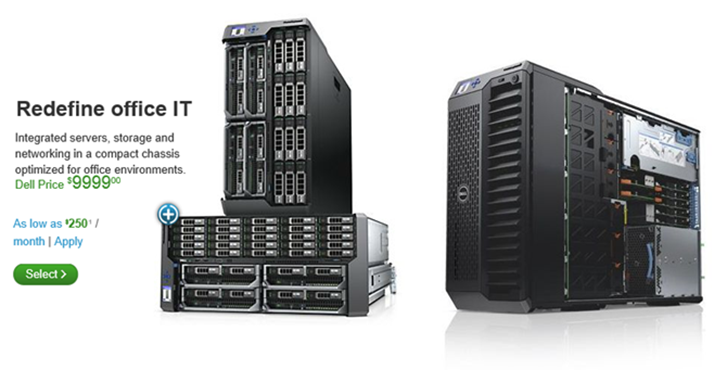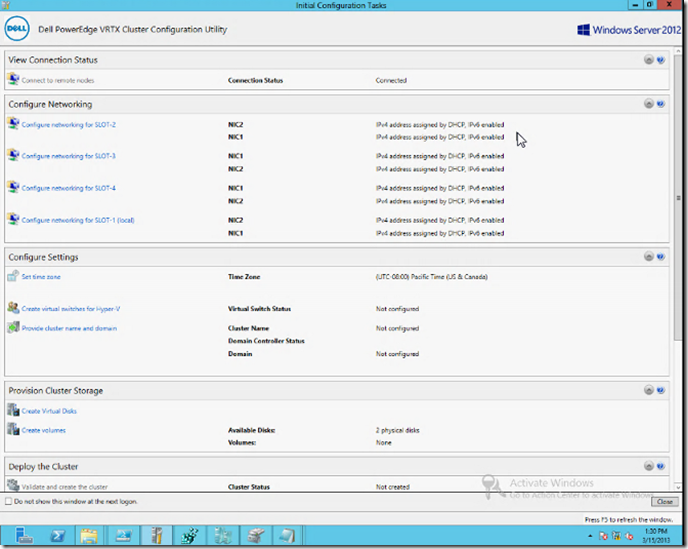- Home
- Windows Server
- Storage at Microsoft
- Dell PowerEdge VRTX: 4-Node Cluster-in-a-Box That Can Be Deployed in 45 Minutes
- Subscribe to RSS Feed
- Mark as New
- Mark as Read
- Bookmark
- Subscribe
- Printer Friendly Page
- Report Inappropriate Content
Hi Folks –
Dell’s latest server, the PowerEdge VRTX Shared Infrastructure Platform is an incredible cluster-in-a-box that delivers highly-available services and storage in one beautiful package. There are some great innovations in this chassis, for sure; the shared PCI bus and virtualized PERC8 storage controllers are really ground breaking stuff. However, what really has me impressed is the price. On the Dell website today, they have this chassis and two blades available for under $10,000, which is about as low a price as you can find for a Windows Server 2012 cluster with hardware RAID!

Dell bills the PowerEdge VTRX as a solution that “redefines office IT.” And I’m inclined to agree: its innovative, converged design is based on a modular chassis that supports 4 compute nodes and up to 48TB of storage in a 5U rack-mount enclosure—or you can turn it sideways and it’s a tower that fits under your desk. It’s great for small businesses, which often face space constraints, hardware sprawl, low tolerance for heat and noise, and a lack of datacenter-class power or cooling. The PowerEdge VRTX is built to address all these issues, making it easy to deploy compute and storage resources wherever you need them.
A Four-Node Cluster-in-a-Box That Can Be Deployed in 45 MinutesThe speed with which the PowerEdge VRTX can be deployed is just as impressive as its physical design. Last year, I blogged about how the OEM Appliance OOBE (out-of-the-box experience) originally developed for Windows Storage Server was being included in Windows Server 2012 (Standard and Datacenter Editions) as well as both editions of Windows Storage Server 2012. At that time, it supported the deployment of standalone servers or 2-node failover clusters. This spring, the Windows team released an update that adds support for 4-node clusters. During its development, we worked closely with Dell using original prototypes of the hardware.
Dell is including that update with the PowerEdge VRTX to deliver a four-node cluster-in-a-box that can be deployed in 45 minutes. After powering-on the system, the user can simply follow the sequence of tasks provided by Dell, which include configuring the network, joining a domain; provisioning some storage, and creating the cluster. Here is a screenshot that shows the Initial Configuration Tasks window:

And here’s a great shot of the Dell booth at TechEd, where they highlighted the PowerEdge VRTX and how quickly it can be deployed.

Dell’s innovative PCI-e virtualization technology and PERC8 storage controller enable simultaneous access to storage from each server node. This reduces the overhead in accessing shared storage and also reduces the total storage needed by allowing each server node to share the same physical storage resources.
Such innovations make the PowerEdge VRTX a great Hyper-V host. You can easily scale-up RAM, add more CPUs, and install additional PCI-e add-in cards (including several 10GbE options from Intel and Broadcom) to run numerous VMs at once, handle huge SQL instances, or support thousands of IIS workloads—all while migrating running VMs from one node to another at lightning speed. You can easily assign the shared PCI-e slots to any of the nodes using the system’s Chassis Management Controller (CMC).
Dell recently released a reference architecture to help customers deploy virtualized desktop infrastructure (VDI) workloads on the PowerEdge VRTX using Hyper-V. The reference architecture includes sizing guidance for two default configurations: two M620 blades and 15 disks, which is designed to support 250 virtual Windows 8 desktops; and four M620 blades and 25 disks, which is designed to support 500 virtual Windows 8 desktops. You can configure and price these solutions using Dell’s Solutions Configurator .
System SpecificationsDetailed system specifications for the PowerEdge VRTX can be found on the Dell website or the downloadable data sheet . Here are a few highlights:

Recap
Put simply, the PowerEdge VRTX has the potential to be a game-changer when it comes to office IT. I’m hard-pressed to think of another system that can match all the benefits that the PowerEdge VRTX has to offer, including:
- Optimized for office environments. The PowerEdge VRTX is a compact, shared infrastructure platform with office-level acoustics and 110V power support. It provides front-access KVM, USB, LCD display, and optional DVD-RW, and can be deployed as a standalone tower or a 5U rack enclosure.
- Converged servers, storage and networking. The PowerEdge VRTX combines servers, storage, and networking to provide impressive performance and capacity. A single chassis supports up to four dual-socket PowerEdge M520 or M620 server blades, up to 8 PCI devices, and up to 48 TB storage capacity. It is very easy to add additional blades to scale the system if you start with 2 or 3 blades.
- Flexible shared storage. All four server nodes have access to low-latency, shared internal storage, making the PowerEdge VRTX ideal for virtualization and clustering, highly economical, and easier to manage than traditional SANs. A single chassis can support up to 12 3.5” HDDs (48TB max) to scale for capacity or up to 25 2.5” HDDs (30TB max) to scale for performance.
- Integrated networking and flexible I/O. The PowerEdge VRTX includes an embedded gigabit Ethernet switch, eliminating the need to purchase a separate networking device. An optional pass-through Ethernet module option with eight GbE ports supports up to 8Gb aggregate bandwidth. PCIe resources are shared across the compute nodes within the chassis.
- Simple, efficient systems management. A rich, unified system management console reduces administration time and effort, enabling you to deploy, monitor, update, and maintain the system through a single pane-of-glass that covers servers, storage and networking. Dell OpenManage 1.2 with Chassis Management Controller (CMC) and GeoView enable you to monitor all PowerEdge VRTX systems, anywhere on your network.
- Seamless management integration. PowerEdge VRTX systems management integrates with major third-party management tools, allowing you to use what you already know and own. This makes it easy to deploy VRTX into infrastructures already managed by Dell OpenManage or third-party management solutions, such as Microsoft System Center and VMware vCenter.
If the above has you interested in Dell’s PowerEdge VRTX, the Shared Infrastructure page on the Dell website is a good place to start. I think you’ll be impressed… I know that I am.
Cheers,
Scott M Johnson
Senior Program Manager
Windows Server OEM Appliance OOBE
You must be a registered user to add a comment. If you've already registered, sign in. Otherwise, register and sign in.